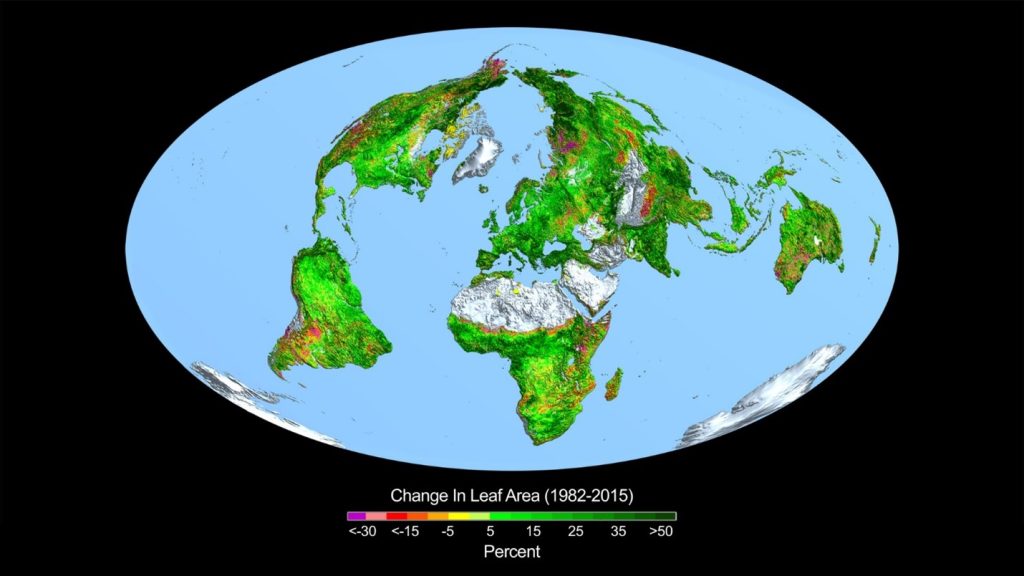Phys.org published an article describing research which claims, “world’s boreal forests may be shrinking.” This claim is refuted by data showing that boreal forests are experiencing a general greening trend, with forest extent and leaf cover expanding, the same as other ecosystems and bioregions.
The Phys.org story, “The world’s boreal forests may be shrinking as climate change pushes them northward,” cites research which speculates that the southern fringe of the boreal forests could shrink faster than its northern boundary expands, leading to an overall decline in biodiversity in largely wild boreal forests which “circle our planet’s far northern reaches, just south of the Arctic’s treeless tundra… The boreal region’s soils have long buffered the planet against warming by storing huge quantities of carbon and keeping it out of the atmosphere.”
At the outset, it is clear that there is more than a small amount of uncertainty in the claims made by the researchers at Phys.org. The article is long on speculation. What data it presents lend limited credence to the concerns raised about declining boreal forests. Concerning trends of slowing growth and a two-year relative dry spell at the boreal forest’s southern fringe, which was accompanied by increased insect infestation and wildfires, they write:
“If this happens at a larger scale, southern boreal forest boundaries will thin and degrade, thereby retreating farther north, where temperatures are still suitable.”
Yet, they acknowledge that the expansion of forests in the Northern Boundary could cancel out losses at the Southern boreal forest rang, writing:
“If boreal forests expand northward and retreat in the south at the same rates, they could slowly follow warming temperatures. … Will trees in the far north ever catch up with climate and prevent forest contraction? At this point, scientists simply don’t know.”
Leaving aside the speculation and examining what we do know with some certainty about the boreal forests. In the Phys.org’s own words:
Our recent studies using satellite data showed that tree growth and tree cover increased from 2000 to 2019 throughout much of the boreal forest.
…
Our studies also revealed that tree growth and tree cover often decreased from 2000 to 2019 in warmer southern areas of the boreal forests.
Satellite data makes it clear that climate change is affecting both the northern and southern margins of the boreal forest. However, if tree cover loss in the south occurs more rapidly than gains in the north, then the boreal forest will likely contract, rather than simply shifting northward.
There’s that pesky word, “if” again. Leaving the speculation aside, the researchers’ own data indicate that although there has been some decline in the tree cover at the southern edge of the boreal forest, there has been an increase in tree growth and tree cover for the boreal forest as a whole. This suggests that the northern expansion and growth is occurring faster than any southern decline, meaning the boreal forests, like other forests around the world, are adapting to climate change and benefitting like plant life in general has from increasing concentrations of CO2 in the atmosphere.
Indeed, satellite data indicates that from a quarter to half of Earth’s vegetated lands have experienced significant greening over the last 35 years largely due to rising levels of atmospheric carbon dioxide, as NASA researchers reported in a study published in the journal Nature Climate Change. In fact, boreal forests have been among the biggest beneficiaries. The graphic below, from NASA, indicates that boreal forests are greening faster than most of the world’s other ecosystems, in general.

Credits: Boston University/R. Myneni
Note that boreal forests are amongst the few areas with the deepest green color, indicating a greater than 50 percent increase in growth.
NASA’s satellite-based assessment of the upward trend in boreal forests was confirmed in a 2019 study published in the journal Environmental Research Letters, which found:
Of the 3861 514 km2 in the study region [Arctic-Boreal area], nearly half (1648 210 km2; 42.7% of the domain) showed significant NDVI trends. About a third of the domain (1309 937 km2; 33.9%) was greening and just under a tenth of the domain (338 272 km2; 8.8%) was browning (figure 1(a)).
So, amid climate change, tree growth and range expansion across the Earth’s boreal forests exceed tree decline, no ifs, ands, or buts.
Following the science means following the data which shows that the Earth’s boreal forests have benefited from increased carbon dioxide concentrations and modest warming. One can speculate all day, as the researchers responsible for the Phys.org story did, but in doing so, being honest, they should have suggested that things were getting better for the boreal forests, not that they were likely “shrinking,” or that they and the wildlife that inhabit them were threatened by the Earth’s modest warming. The latter may fit the popular alarmist’s narrative that a climate disaster is in the offing, but it does not reflect the facts.















